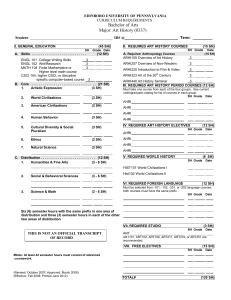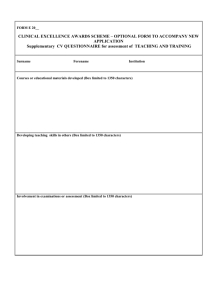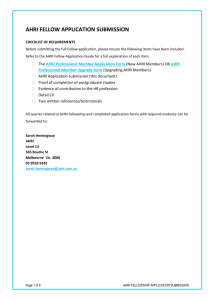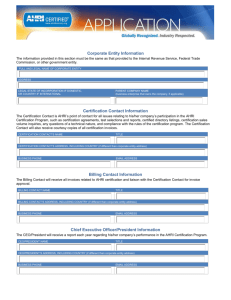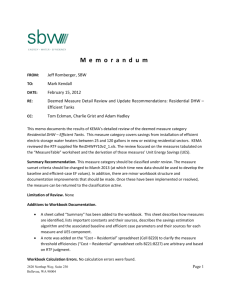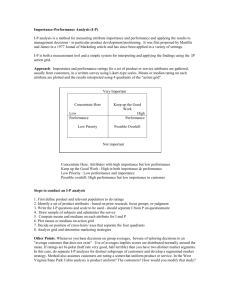Air-Handling Unit Casings
advertisement
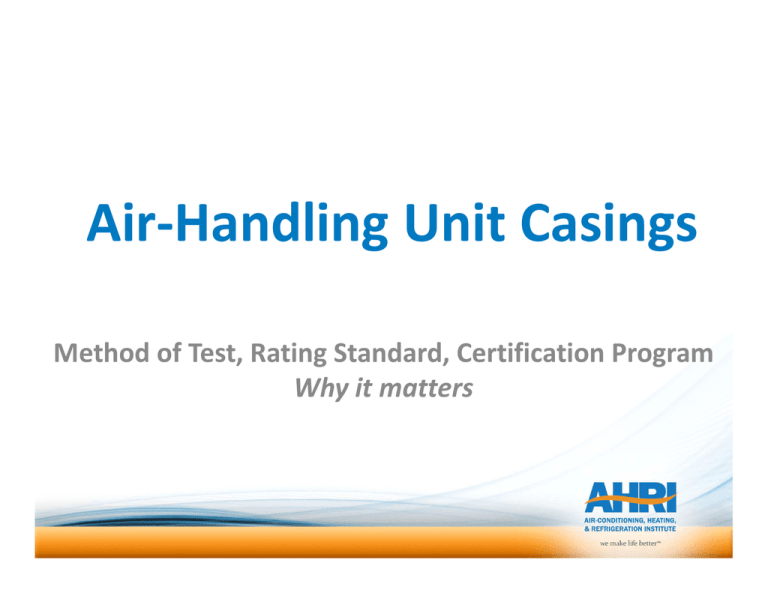
Air-Handling Unit Casings Method of Test, Rating Standard, Certification Program Why it matters Learning Objectives AHRI Standards 1350 (I-P) and 1351 (SI), Mechanical Performance Rating of Central Station Air-handling Unit Casings – Scope – Ratings – Method of Test Central Station Air-handling Unit Casings (AHUC) Certification Program – – – – Annual testing Real units Optional thermal certification Unit inspection AHRI Standards 1350 (I-P) and 1351(SI) Scope – The enclosure which houses the fans, coils, filters, and other components of the CSAHU. Generally made of metal and lined, as necessary, with material for thermal insulation and/or acoustic attenuation. Contains the air that is being conditioned, is exposed to the fan pressure, and separates the conditioned air from the surrounding air. Also called the CSAHU cabinet. Scope Exclusions – Unitary Small Equipment and Unitary Large Equipment – Direct expansion dedicated outdoor air system units – CSAHU’s designed to only operate with internal casing pressure between -1 in. H2O and 1 in. H2O [-250 Pa and 250 Pa] AHRI Standards 1350 (I-P) and 1351(SI) Establishes: – – – – – – definitions; classifications; test requirements; rating requirements; minimum data requirements for Published Ratings; marking and nameplate data; Allows for equal comparisons of AHU Casings based on a standardized method of test. From a single tested unit, 5 ratings are derived AHRI Standards 1350 (I-P) and 1351(SI) The 5 ratings derived: – – – – Casing Air Leakage Class Casing Deflection Rating Class Thermal Bridging Class Thermal Transmittance Class • With and Without Leakage AHRI Standards 1350 (I-P) and 1351(SI) Casing Air Leakage Rate – The air flow leaking through the casing of a Central Station Air-handling Unit per 100 square feet [10 m2]of Casing Surface Area, cfm/100 ft2 [L/s/10 m2] Leakage Class – The rating class designation that defines the maximum expected air flow leakage, cfm/100 ft2 [L/s/10 m2], of the CSAHU casing operating within the interior pressure conditions specified for the total casing surface area – Negative and positive positive negative AHRI Standards 1350 (I-P) and 1351(SI) Casing Air Leakage Rate AHRI Standards 1350 (I-P) and 1351(SI) AHRI Standards 1350 (I-P) and 1351(SI) ି.ହ 4ି.ହ = · =9· = 9 · 0.406 = 3.65 = 1 ି.ହ 6ି.ହ = · =9· = 9 · 0.312 = 2.81 = ଷ 1 AHRI Standards 1350 (I-P) and 1351(SI) Casing Deflection – The deformation of the external surface of the casing, measured perpendicular to the plane of the casing surface, when the unit is subjected to a positive or negative internal air pressure, in. [mm] Deflection Class – The rating class designation defined by the CSAHU’s Maximum Normalized Deflection at the corresponding Rating Differential Static Pressure. AHRI Standards 1350 (I-P) and 1351(SI) Rating Differential Static Pressure – The differential static pressure required for determining Deflection Class, in H2O [Pa]. Span – The shortest linear dimension of the CSAHU casing, width, height or depth, to be used in calculating the relative deflection of the corresponding surface. AHRI Standards 1350 (I-P) and 1351(SI) 0 min. 5 min. 10 min 15 min Avg. Pressure (Pi), in H2O 8.02 8.03 8.01 8.03 8.02 Deflection at Maximum Deflection Point, inches 0.3857 0.3861 0.3862 0.3855 0.3859 94 in. ஔೞೌೝ ାஔೌ δbaseline= ଶ .ସହା.ସଽ δbaseline= ଶ = 0.0047 δnet= ̅- δbaseline=0.3859-0.0047=0.3812 δnet= ̅- δbaseline δ =δavg=0.3859 ஔ ೞೌ δnd= = .ଷ଼ଵଶ ଽସ = .004055 AHRI Standards 1350 (I-P) and 1351(SI) Thermal Bridge – The minimum temperature difference between the dry-bulb air temperature inside the unit and the exterior surface temperature of the CSAHU. Thermal Bridging Factor Thermal Bridging Class – The rating designation class that defines the Thermal Bridging Factor. AHRI Standards 1350 (I-P) and 1351(SI) Thermal Bridging Class AHRI Standards 1350 (I-P) and 1351(SI) − ௦ 106 − 83 = = = 0.6388 = ଶ − 106 − 70 − ௦ 106 − 77 = = = 0.8055 = ଵ − 106 − 70 AHRI Standards 1350 (I-P) and 1351(SI) Thermal Testing – Test-set-up AHRI Standards 1350 (I-P) and 1351(SI) Thermal Testing – Test-set-up AHRI Standards 1350 (I-P) and 1351(SI) Thermal Testing – Test-set-up AHRI Standards 1350 (I-P) and 1351(SI) Thermal Testing – Test-set-up AHRI Standards 1350 (I-P) and 1351(SI) Thermal Transmittance – The rate at which thermal energy is transmitted through the casing with or without air leakage, Btu/h/ft2/°F [W/m2·K]. (Also known as the Uvalue.) Thermal Transmittance Class – The rating designation class that defines the maximum rate at which energy, Btu/h/ft2/°F [W/m2·K], will be transmitted through the CSAHU casing as a function of total casing surface area and temperature difference from interior to exterior of the unit with or without the calculated rate of energy lost through air leakage at Standard Rating Conditions. AHRI Standards 1350 (I-P) and 1351(SI) Thermal Transmittance AHRI Standards 1350 (I-P) and 1351(SI) The unit has a total surface area (excluding block-off panels) of 140 ft2 (Anet) and the measured leakage is 17.1 cfm (Qanet) and the power input for the heaters is 0.19 kW and 0.37 kW for the circulating fans. = 3412.14 · = 3412.14 · (௧௦ +. 3412.14 · (0.19 + .37)=1910.7984 = 60 · ρ · · ௧ · − = 60 · 0.076 · 0.241 · 17.1 · 106 − 68 = 741.104 ௦ )= ௧ = + = 1910.7984 + 741.104 = 2651.9024 2651.9024 ௧ = = 0.40302 = ସ ௪௧ = 140(113 − 66) ௧ − ܷ௪௧௨௧ = ܣ௧ ݍ 1910.7984 = = 0.2904 = ܶܥଷ ܶ − ܶ 140(113 − 66) AHRI Standards 1350 (I-P) and 1351(SI) Thermal Performance Rating Limitations – Thermal performance ratings are intended to be used only to compare the construction of different Central Station Air-handling Units. – The numerical value associated with the rating class cannot be used to predict actual application Thermal Transmittance through casing or the risk of condensation for any specific Central Station Air-handling Unit. AHRI Standards 1350 (I-P) and 1351(SI) AHRI Standards 1350 and 1351 are available on AHRI’s website – As with all AHRI standards, they are available to download at no cost – The download of 1350 of 1351 includes the entire method of test Why Choose AHRI-Certified Products Foremost globally recognized HVACR & water heating certification program Voluntary program Qualification is lengthy and rigorous 400+ participants across all program – 600 Licensees – Including 58 International Licensees from 16 countries 2,500 independent laboratory tests annually Accredited by Standards Council of Canada (SCC) Why You Can Trust AHRI AHRI contracts with a third-party lab to conduct all tests Products are randomly selected for testing Operation Manuals dictate strict procedure for administration of the certification program AHRI Directory is recognized by government agencies – EPA (Environmental Protection Agency) – DOE (U.S. Department of Energy) – FTC (Federal Trade Commission) – NRCan (Natural Resources Canada) – CEC (California Energy Commission) Third-party Verification Manufacturer performance ratings verified by a third-party laboratory Holds manufacturers accountable Provides consumers with confidence in performance of the product AHUC Certification Program A Participant’s listing shall be grouped by BMG. At a minimum, a BMG is a regular range of units having the construction and similar geometry parameters and no more than two (2) classes in any singular rating class (i.e. CD1 and CD2) as stated below: Similar wall construction – Single Wall • Frame and/or Panel construction variations (i.e. 2’ center to center distances) – Double Wall • Frame and/or Panel construction variations – Similar insulation thickness and type (i.e. 2” fiberglass or 4” foam) – Similar assembly method (i.e. similar Seam Construction, seam treatments, bracing, caulking, gasketing, etc.) Qualification Process Application Submittals – Application is separately applied to each Certification Program – Ratings provided for all models (Certify All) Testing – 20% Basic Model Groups are tested – Conducted by a 3rd party lab (not AHRI) – Laboratories in the US and Asia Qualification Process Sample Inspection How to Join the Central Station Air-handling Unit Casings (AHUC) Certification Program Step 1: Certification Application Package – A. AHRI sends Interest Letter to OEM: • • • • • • Application for AHRI Certification (certification & billing contact form) Annual Sales Volume form Product-specific data submittal sheets One test report for every BMG or Basic Model subject to certification. Witness Facility Approval paperwork (if applicable) Selection software programs (in lieu of paper catalog) – B. AHRI receives completed documentation within 60 calendar days and sends confirmation. Step 2: Processing Application Package – A. AHRI sends Participation and License Agreement for OEMs – B. AHRI sends Participation and License Fee Invoice How to Join the Central Station Air-handling Unit Casings (AHUC) Certification Program Step 3: Selection and Qualification Testing – A. AHRI sends Qualification Selection Letter • Acquisition of qualification test samples • Witness test program provisions – B. Qualification Test Results: • IF QUALIFICATION TESTS PASS: – Proceed to step 4 • IF QUALIFICATION TESTS FAIL: – AHRI will send a Manufacturer’s Decision Form (MDF). – The applicant will have 7 calendar days to respond to AHRI with one of the following decisions: » 2nd sample » Re-rate » Discontinue the qualification process How to Join the Central Station Air-handling Unit Casings (AHUC) Certification Program Step 4: Acceptance into the program – A. AHRI sends Welcome Letter and executed Agreement to the applicant – B. Applicant’s data will be uploaded to the AHRI Directory of Certified Product Performance Central Station Air-handling Unit Casings (AHUC) Certification Program Participants GD Midea Heating & Ventilating Equipment Co., Ltd. Central Station Air-handling Unit Casings (AHUC) Certification Program Annual Testing Once the qualification process has completed, a Participant is subject to annual testing. – 10% of a Participant’s BMGs shall be tested annually, with a minimum of two (2) models. – 25% of a Participant’s Annual Testing samples shall have a Sample Inspection with at least one sample verified every 2 testing years. Importance of AHRI-certified AHU Casings Third-party verification of published ratings Voluntary Failures are noted for one year – Re-rates are required to consistent with tested results and must be approved by AHRI in the Participant’s software/catalog. Allows for equal comparisons of AHU Casings based on a standardized method of test through the AHRI Directory. How to Incorporate AHRI Certified Ratings Example specifications – “Each unit shall have an AHRI-certified casing with a minimum rating class of CD2 for deflection, CT2 for thermal transmittance, CL2 for leakage, and CB2 for thermal bridging.” Questions?
